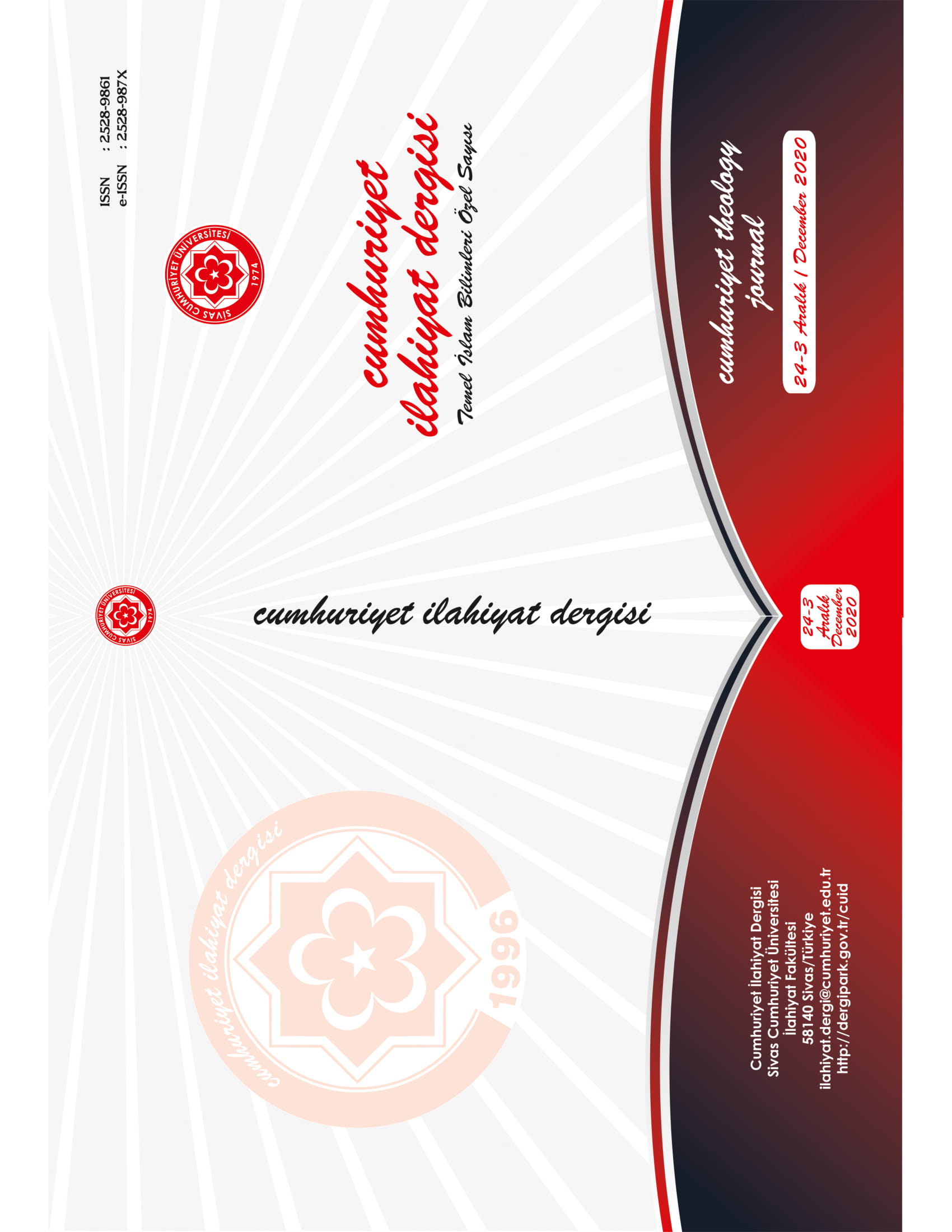Meâller İltifât Sanatını Yansıtıyor mu? -Mâzi ve Muzâri Fiil Kipleri Arasındaki İltifât Sanatı Örneği-
Do the Translations of the Qurʾān Reflect the Art of Iltifāt (Reference Switching)? - The Example of the Art of Iltifāt Between Māzi and Muzāri’ Verb Modes-
Author(s): Osman ArpaçukuruSubject(s): Language studies, Language and Literature Studies, Theology and Religion, Islam studies, Translation Studies
Published by: Cumhuriyet Üniversitesi İlahyat Fakültesi
Keywords: Arabic Language and Balāgha; Reference Switching (Iltifāt); Qurʾān; Qurʾānic Studies; Styles of the Qurʾān; Translation; Turkish Translations of the Qurʾān;
Summary/Abstract: The iltifāt (reference switching) is one of the arts of high literary value, widely practiced in the Qurʾān. This art takes place in the form of switching to another person, verb mode, number, preposition or sentence type contrary to the necessity of the situation, while continuing the word as a certain person, verb mode, number, preposition or sentence type. The art of iltifāt adds certain meanings to words such as certainty, continuity and movement. It keeps the curiosity, desire, excitement and shiver alive. Similar to those who read the Qurʾān, those who read the translation of the Qurʾān are expected to be able to notice these meanings as much as possible and feel the literary pleasure of this art. There are important structural differences between Arabic and Turkish. In addition, the text that needs to be translated into Turkish is Holy Qurʾān, which has a divine infinite dimension, and it is a limited human mind attempts to translate it. This situation requires an advanced level of caution and diligence in transferring the art of iltifāt to the translations of Qurʾān. The issue of the art of iltifāt and the transfer of this art to the translations of the Qurʾān has also been studied in scientific research in different world languages such as Arabic, English and Indonesian. As far as we can determine, the only study in Turkish that examines the reflection of the iltifāt in the Qurʾān is the article titled "The Translation Problem of the Art of iltifāt in the Translation of the Qurʾān" by Haşim Özdaş. In the mentioned article, five different Qurʾān translations of eight verses from different types of the art of iltifāt were examined. It has been claimed that there is no art of iltifāt in Turkish language and literature, and that the translation of the art of iltifāt in the verses into Turkish is an obstacle to understanding the verses and leads to a wrong or incomplete understanding. As a solution, while the verses are being given and translated, it is suggested that the art of iltifāt in the verses be ignored. In this research article, the cases of the translations of the Qurʾān reflecting the art of iltifāt, as an example of iltifāt between māzī (past tense) and muzāriʻ (present tense) verbs modes in the verses are discussed. In addition, it discusses the opinions that say there is no art of iltifāt in the Turkish language, that the exact transfer of the art of iltifāt found in the Qurʾān to the translations of the Qurʾān causes wrong or incomplete understanding, therefore, the art of iltifāt should be ignored when the verses are being translated. As a result, the present study argues that the art of iltifāt is also a subject of Turkish rhetoric, which should be reflected in the translations of the Qurʾān as much as possible, and the transfer of the art of iltifāt in the translations of the Qurʾān does not constitute an obstacle to understanding the verses, on the contrary, the reference to this art in the verses will contribute to the realization of the divine purpose and wisdom. The data sources of the research were created from 6 verses and their 22 different translations, using various sampling methods. The data collected from these were analysed using the comparative text analysis method on the basis of the inductive approach. Qualitative data was converted into quantitative data, processed in the SPSS application, and the findings were presented as numerical figures in tables. At the end of the research, it was determined that iltifāt between māzī and muzāriʻ verbs modes studied in the science of rhetoric was also a subject of grammar as the phenomenon of time shifts in verbs. It was seen that the art of iltifāt was applied in an average of 800 places in the Qurʾān, and the iltifāt between māzī and muzāriʻ verbs modes accounted for 6.9% (55 pieces) of this amount. Most of these fifty-five iltifāts were iltifāt from the māzī verb mode to the muzāriʻ verb mode (63.6%), while the amount of iltifāt the muzāriʻ verb mode to the māzī verb mode was less (36.4%). In the analysed translations of the Qurʾān, it was determined that the iltifāt between māzī and muzāriʻ verbs modes was not reflected at a rate of 90.9%, and the art of iltifāt was completely abandoned in 14 of the 22 translations. It was concluded that the reason why the art of iltifāt in the verses was not reflected in the translations of the Qurʾān was the belief that this art was not found in Turkish and that the transfer of this art leads to wrong and incomplete understanding. In the research, it was proposed to increase the number of scientific studies in which various translation strategies and techniques were tested in the transfer of the art of iltifāt in the verses in the translations of the Qurʾān. In this respect, this research article is expected to pave the way for more research on the issue of transferring the arts used in the Qurʾān and to be useful for future translations of the Qurʾān.
Journal: Cumhuriyet İlahiyat Dergisi
- Issue Year: 24/2020
- Issue No: 3
- Page Range: 1429-1454
- Page Count: 26
- Language: Turkish

